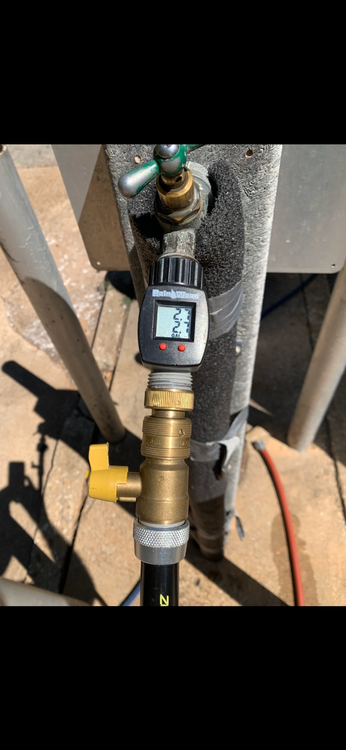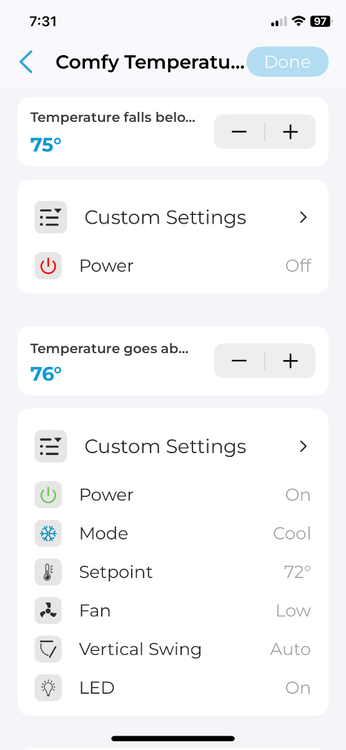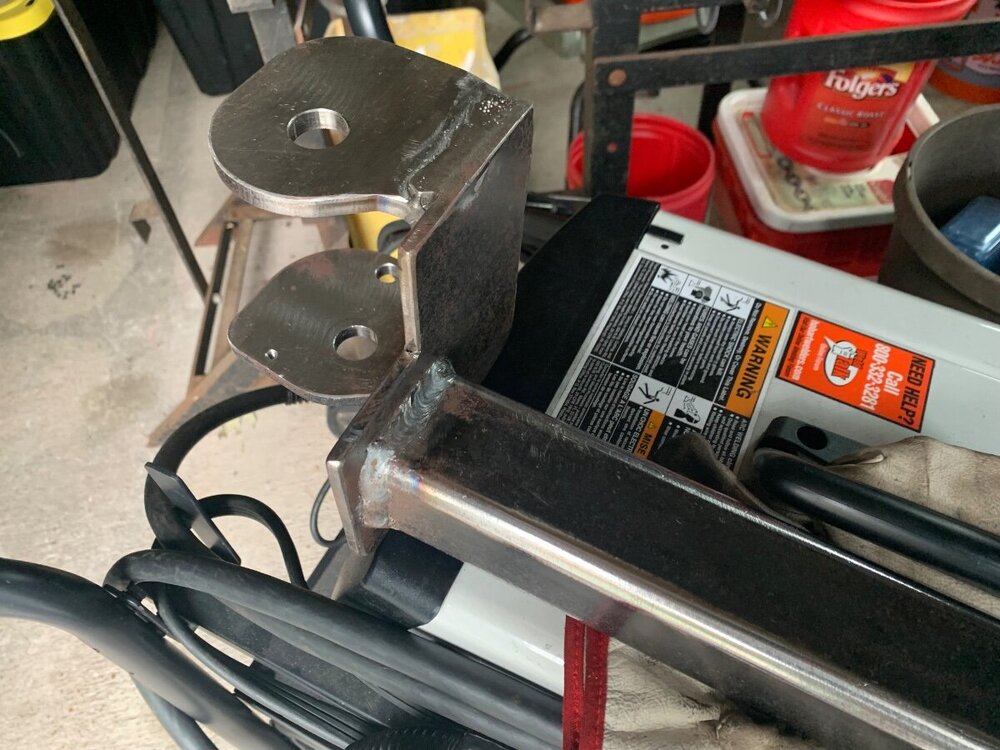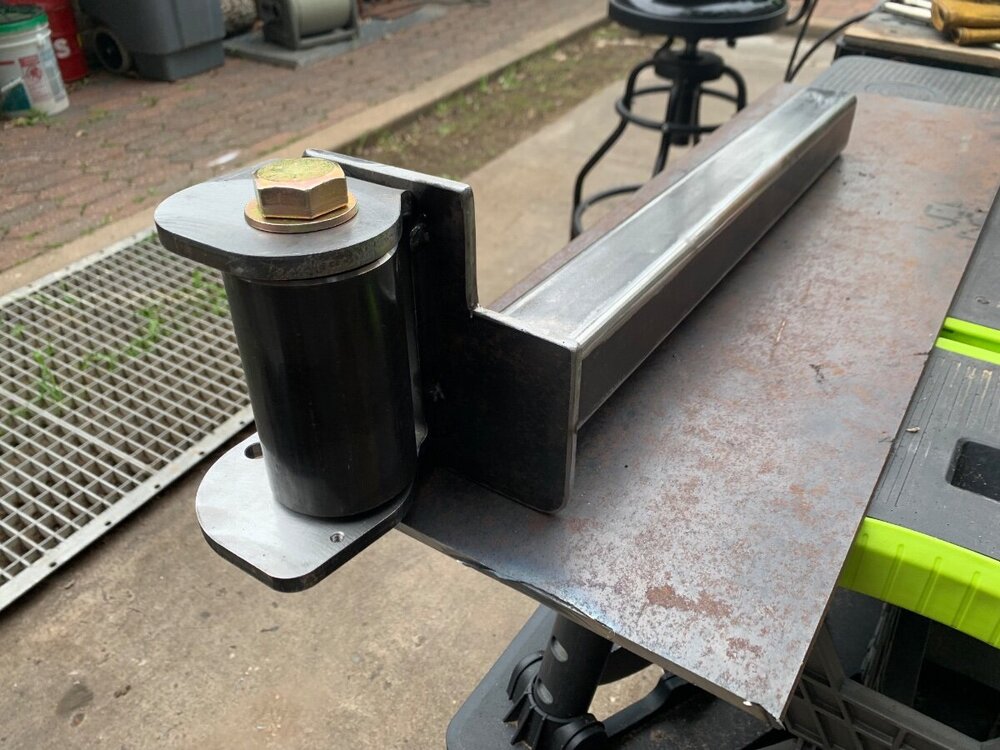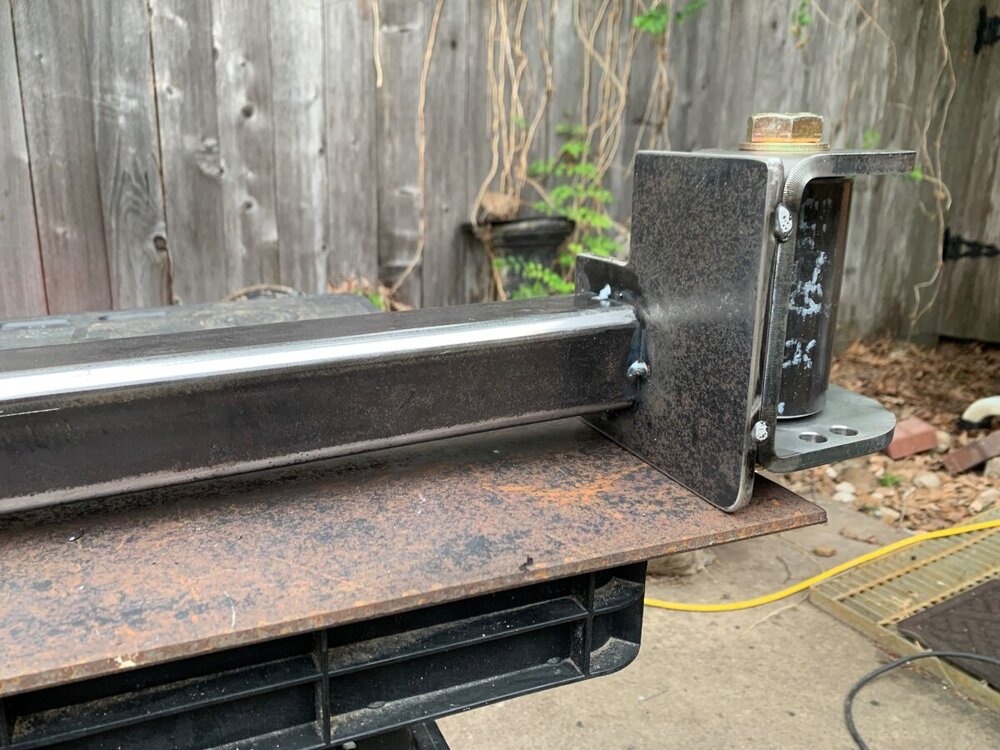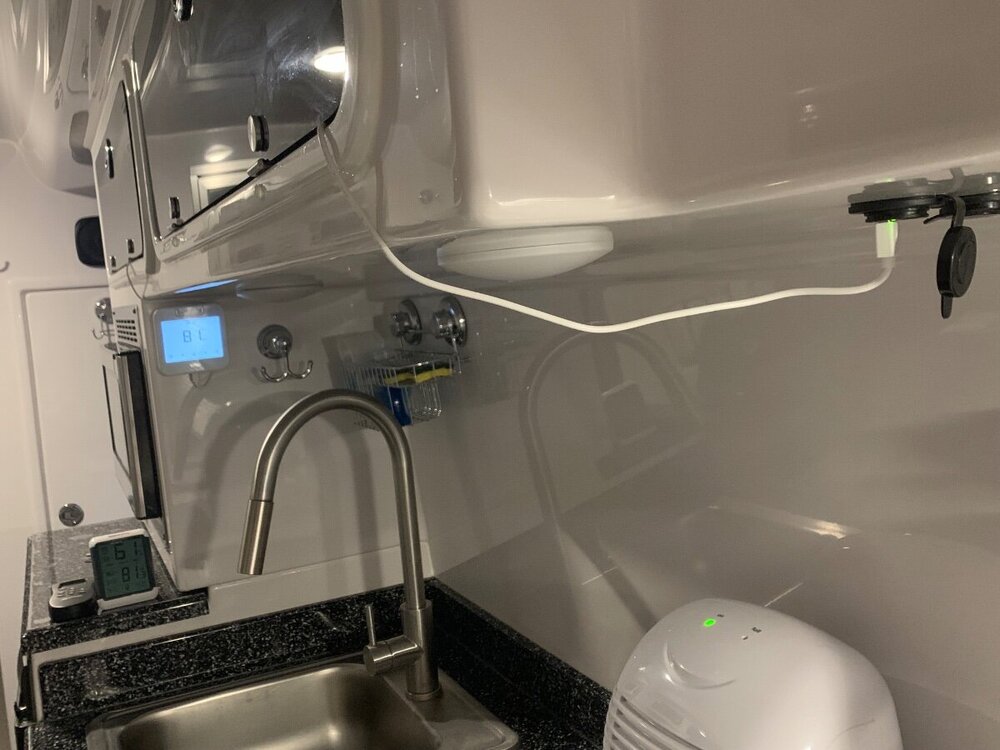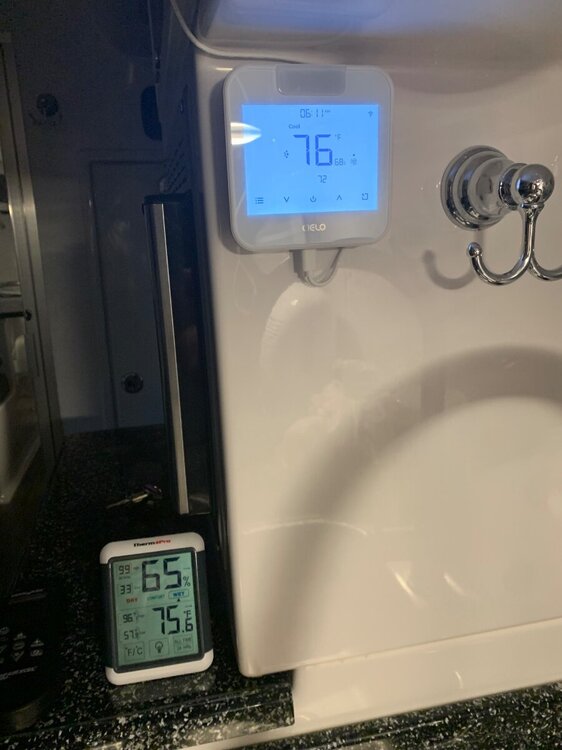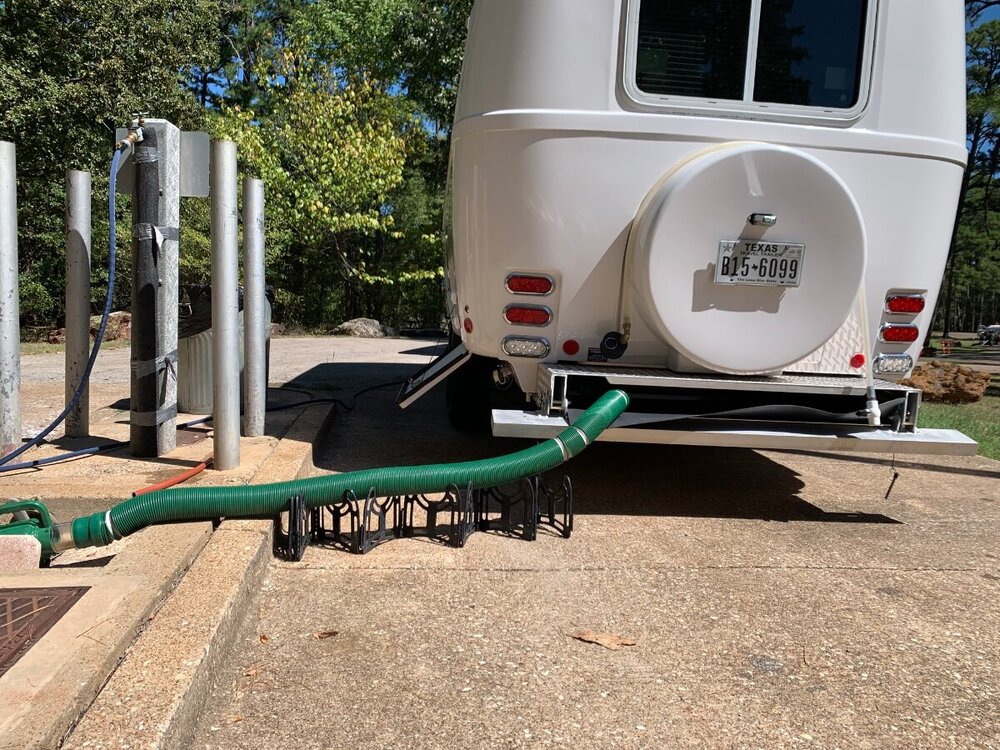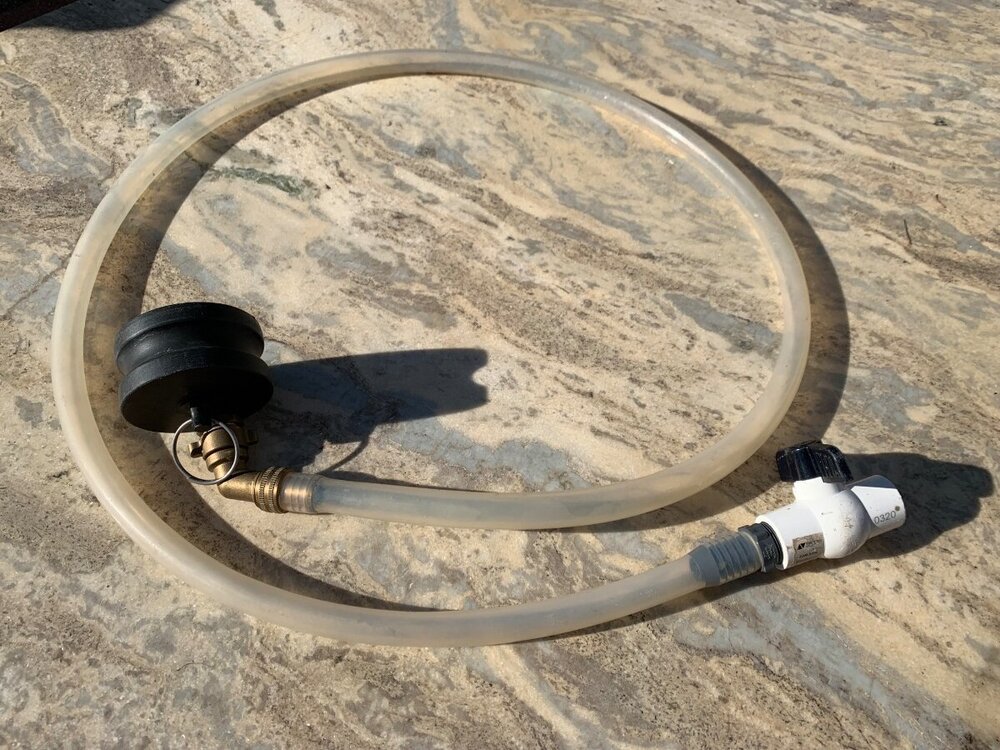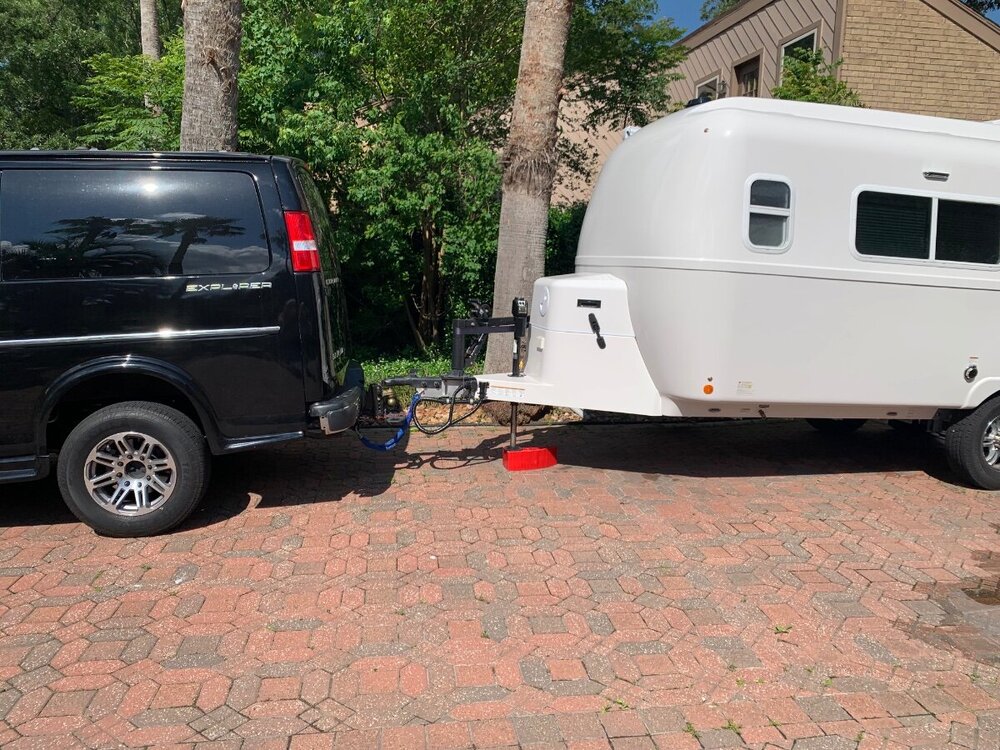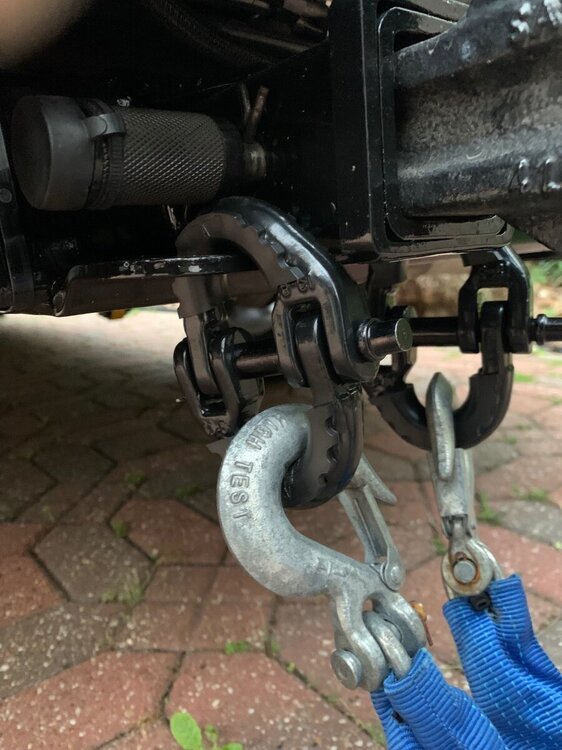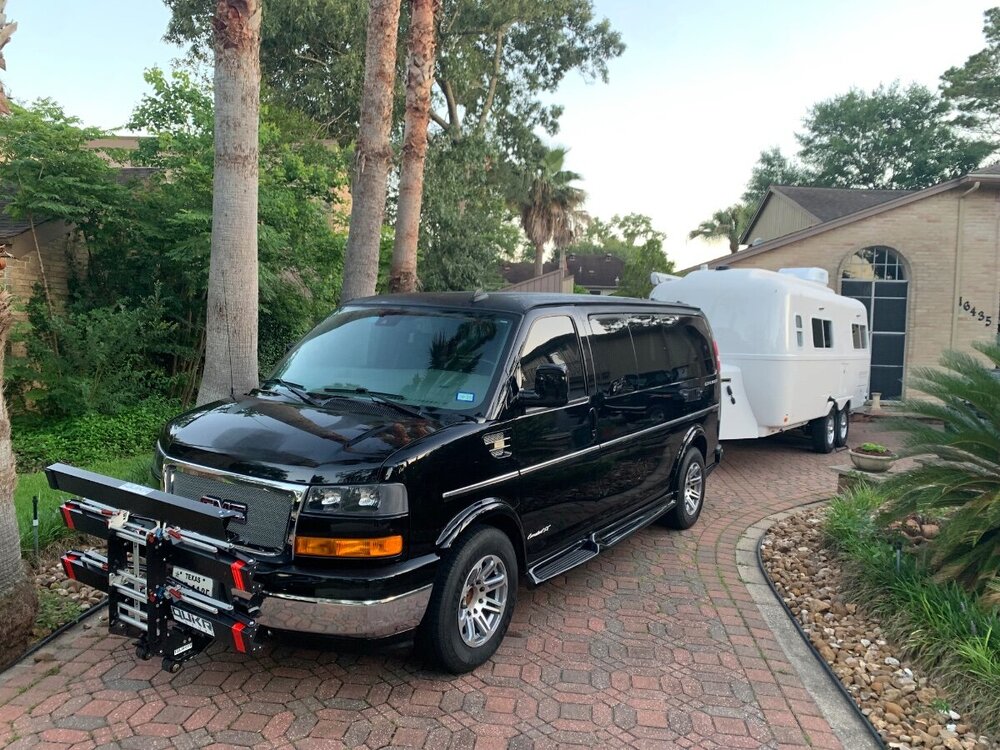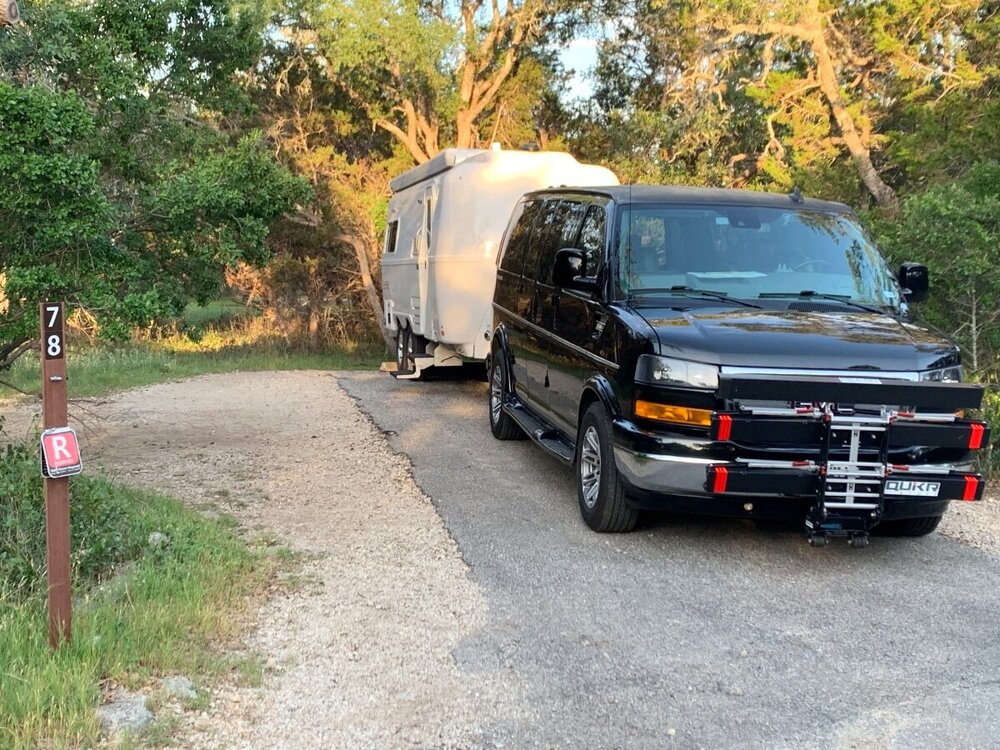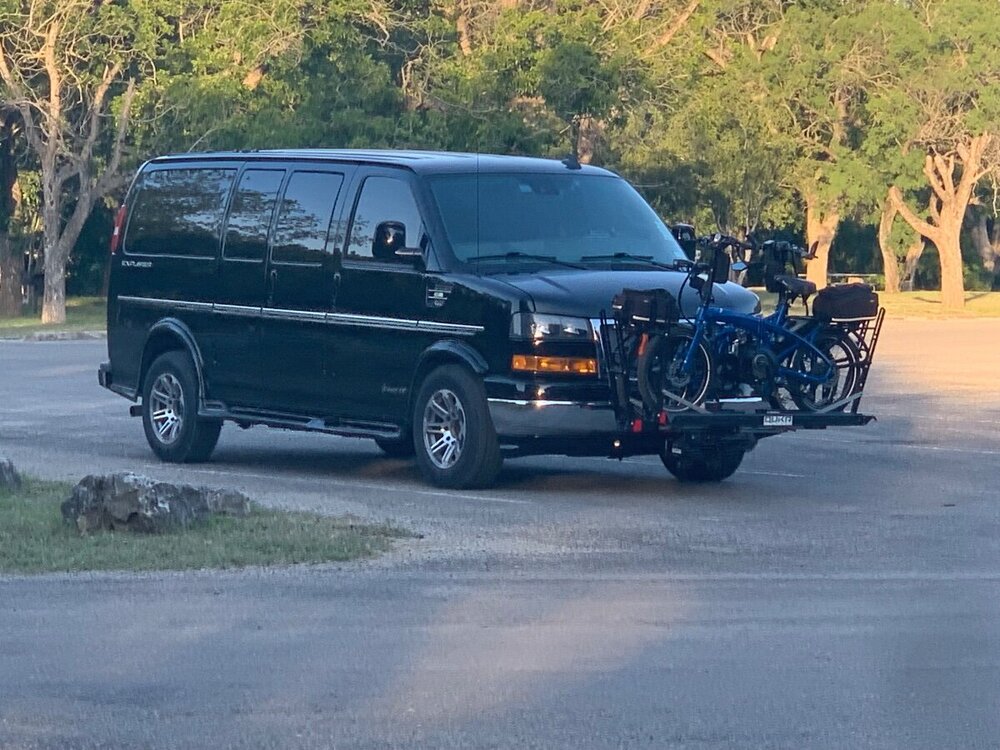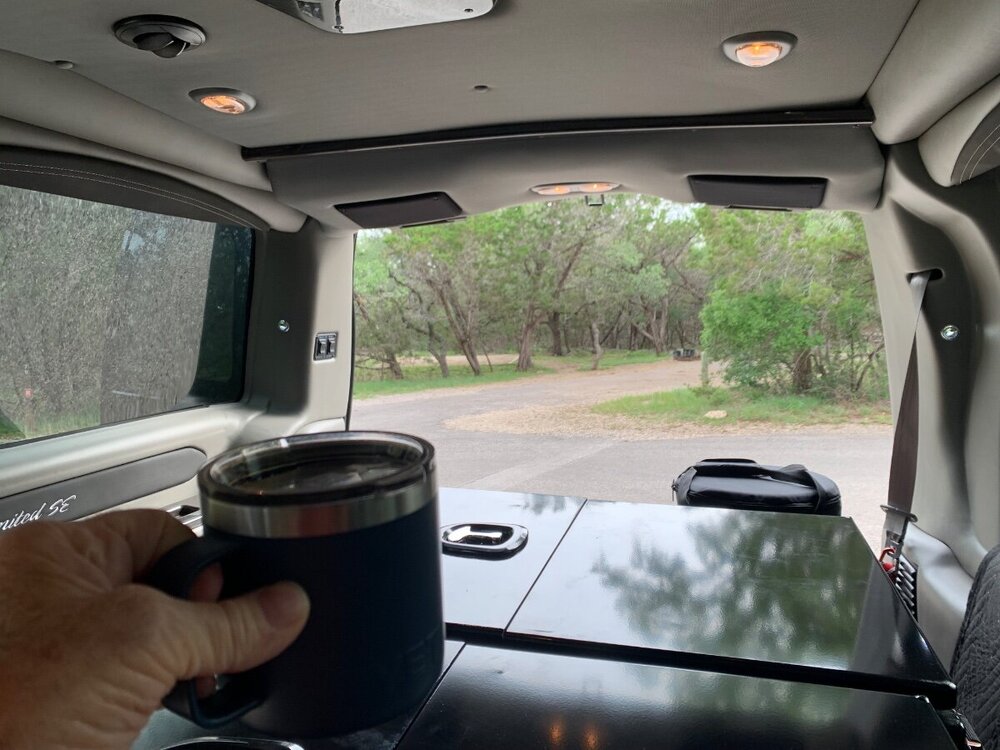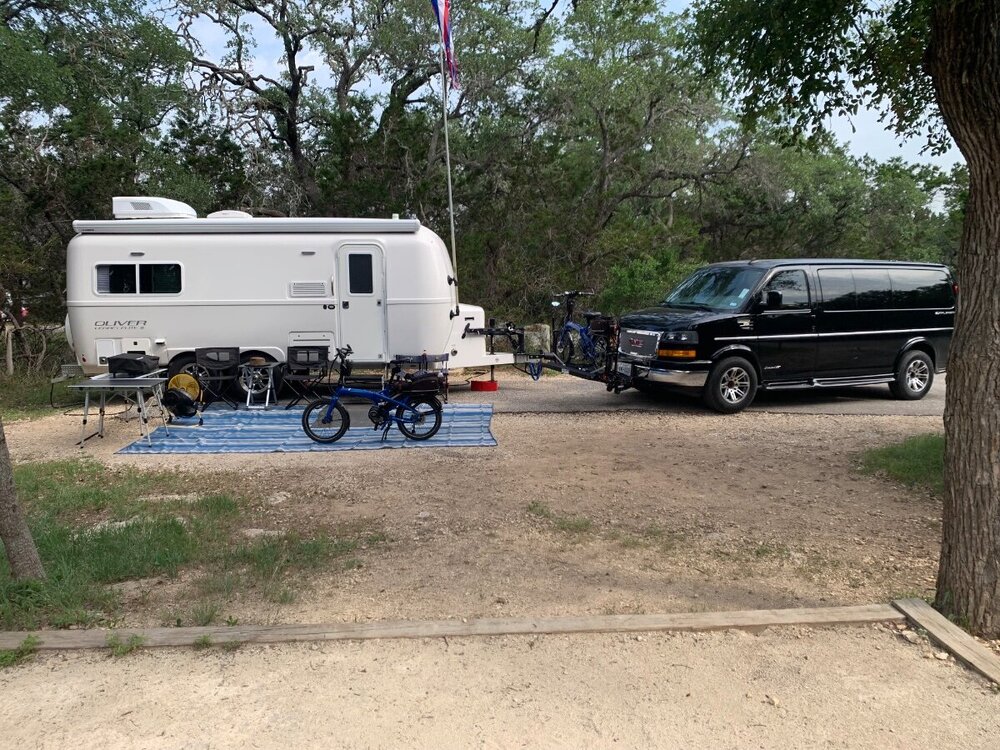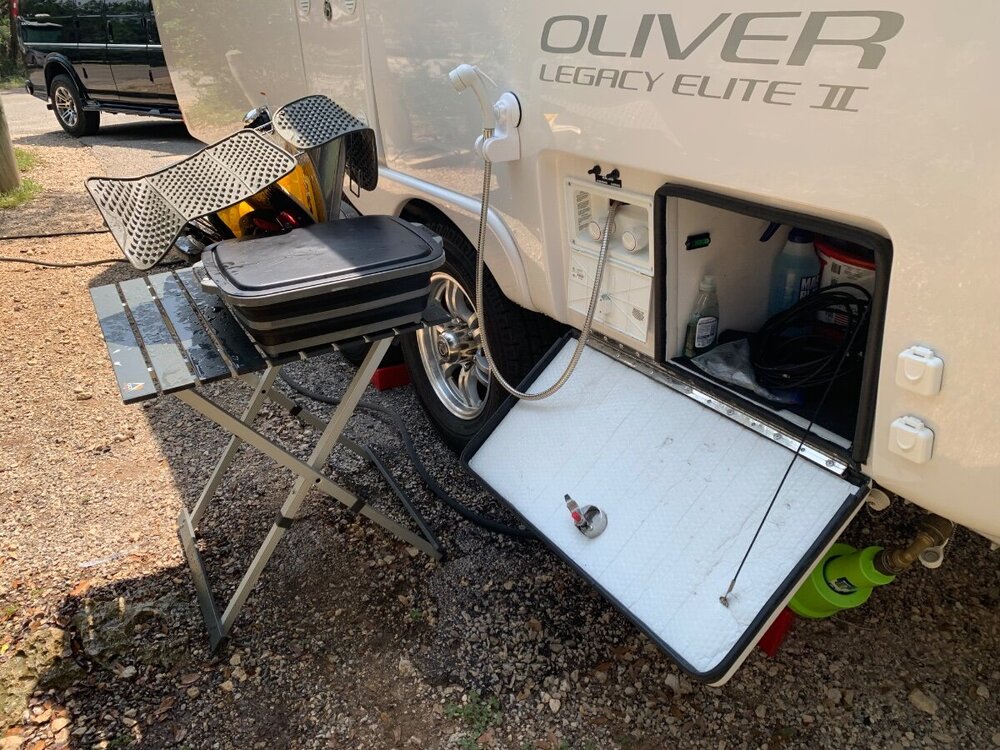-
Posts
1,075 -
Joined
-
Last visited
-
Days Won
31
Everything posted by Ronbrink
-

Gorilla compact 25’ hose for marine and RV use
Ronbrink replied to Patriot's topic in Mechanical & Technical Tips
I have quick connect components on all of my hose ends so no need for tightening/loosening. I also use Teflon tape on all of the threaded connections. I have a 25’ zero-G fitted with a flow meter and stowed in the rear bumper compartment. It doesn’t take up much space and is easy to access. I generally flush the tank a couple of times following the initial dump. With the black tank valve closed, I meter the amount of flush water prior to release and leave the water flowing during the process for added spray action; the process is then repeated. -
My solution, Lifesaver Jerrycan for drinking water and ice. It can easily be refilled from the freshwater tank during extended travels, but in a pinch designed to adequately filter the worst of waters (think survival situations).
-
The following has been found beneficial in ‘Setpoint’ selection in Comfy Mode, but may be applicable with use of Comfy Max Mode, as well; TBD. It is important to know that a setpoint one or two degrees below the upper range of temperature selected will have the fan run more than the compressor prior to power shutdown; whereas a setpoint of three or four degrees will have the fan and compressor turn off in sync, and the outside blower fan runs a half minute or so before total shutdown of the unit. Here’s a screenshot of the Custom Settings for my ‘Day’ Comfy temperature range. Although I have the Vertical Swing set to Auto, there are nine other positions to choose. Once the Atmos is running in a Comfy Mode, the Swing can be temporarily changed. I find this useful when sitting or lying in bed (head at rear) and don’t want the cold air oscillating downward onto me. Pos 1 can be selected to set the Swing to blow straight out. The Fan speed can also be changed, as well. These interim changes will revert back to the original settings next use.
-
I’m sharing my experience in hopes of helping other Oliver owners resolve the inherent humidity issue, regardless of the brand of a/c unit they may have. If found to work with a particular unit, perhaps others can share their experiences.
-
I posted the following comment this morning to address the same humidity issue expressed by a Truma Aventa owner (Truma AC blowing humid air?/Mechanical & Technical Tips). ‘In my post titled Drieha Atmos 4.4 Home Install/Ollie Modifications I recently provided comment on an easy remedy to the humidity issue with my unit, which may be applicable to the Truma Aventa, as well as other makes and models.’ Pertinent information provided therein may be of interest to Hougthon owners, as well.
-
In my post titled Drieha Atmos 4.4 Home Install/Ollie Modifications I recently provided comment on an easy remedy to the humidity issue with my unit, which may be applicable to the Truma Aventa, as well as other makes and models.
-
No vent assembly kit installed. I don’t keep the hose connected because it’s a tight fit when the bumper gate is closed; the bend in the hose is subject to rubbing on the gate, which could eventually cause a hole or tear. I was using the provided cam lock plug to seal the discharge pipe, but had some seepage when removed once; I then tapped a fitting into it to attach the clear silicone tube for previously described purposes. The plug fitted with a threaded hose connection can be bought, but I choose to convert mine. Since the hose is collapsed when stowed, once connected to the discharge pipe the terminal valve has to be cracked to enable air intake to facilitate extension. Stowing is not a problem, since it is disconnected from the discharge pipe and given a final clean water rinse before collapsing.
-
I got sea sick watching the DERUBIS video!
-
Back to last months swing rack builds with Phase 2 of that project; custom swing away racks for my two Wavian Jerry Cans and spare 30# propane tank. Had some supply delays, but now finding time seems to be an issue and thus, I will report as the builds progress. I completed fabrication of the primary driver side swing out carrier hinge and tack welds on the passenger side assemblies. Here’s a few pics:
-
And the Truma for that matter! EDIT: Dometic Penguin ll, as well!
-
Good idea! It also claims ‘The smart air conditioner controller is compatible with over 20,000 models of mini-splits, window, or portable units’. Maybe there will be some owners of SOB units willing to try the Cielo Breez Max and report their findings.
-
The Cielo has to be positioned for line-of-sight with the Atmos controls in the air distribution panel. And yes, an AC outlet or USB port is needed in close proximity; however it is equipped for hardwiring. When learning how to use the Cielo, I sat at the dinette and plugged into an AC outlet via the supplied 5V adapter; the supplied base stand for flat surface staging was also used. Being a wall-mount is best securement in a rolling earthquake, I first tried it on the forward bulkhead to the upper left of the wet bath door, but didn’t like the cord dangling down the wall and it seemed a bit less responsive due to the distance. I then placed it between the two curbside upper cabinets near the under cabinet USB ports above the cooktop, but the 90° orientation didn’t work as well and there would be concerns of rising heat if cooking. Finally I placed it as shown in the pic, whereby the cord runs in and out of the galley cabinet and plugs into said USB port. I used Velcro for the mount, and may eventually hardwire the Cielo through that upper cabinet and tap into the wiring within the access screw port for a cleaner installation. As positioned, the Cielo is in clear view from bed, and I like that the backlight is dimmable or can be turned off.
-
As I understand it, the Cielo line of products is primarily marketed for mini splint air conditioners, but obviously found to be comparable with other types. SDG that sells and installs the Drieha Atmos 4.4 uses these IR Cielo thermostats in some of the Class B RVs they mostly deal with. I haven’t read of any other brands of rooftop units being controlled by a Cielo, but guess it may be possible. I agree, a perfect solution!
-
The Cielo is independent of the remote and actually turns OFF the power to the Atmos 1° below the low temp setting then turns ON the power to the Atmos 1° above the high setting. There is zero power draw during the shutdown period. When using the thermostat, the remote must be turned OFF and the phone app used to control. The remote can be used for normal operation of the unit, but for enhanced features like Comfy Mode the app is used. Selecting the proper temp setpoint will determine if the fan or compressor runs longer at shutdown. I will address that another time. There is also a Comfy Max Mode, which mimics a home HVAC set for heat/cool, but I think the fan is continuous. Did this answer your question?
-
As eluded to in the above quote and my recent comment made in @rideadeuce’s July 18, 2024 post entitled First highway roadtrip with Atmos 4.4 => MI, I am pleased to share the following information gleaned from other SOB forum and FB members. I learned that the Cielo Breez Max is the only wall-mounted thermostat compatible with the Atmos, which has a programmable Comfy Mode that can turn power off based on either temperature or humidity setpoints. For further information on its use and features search ‘Cielo Breez Max Detailed User Manual / Gemaire Distributors’. The Cielo Home app utilizes WlFi for initial settings and preferences, and to pair the Atmos remote. In said mode, once custom temperature or humidity comfort ranges are dialed in, the Cielo will turn on power when the high setting is exceeded and subsequently turn off power when the lower setting is exceeded. This is ‘HUGE’, whereby 1) both the the fan and compressor cycle on and off in sync at startup and shutdown, respectively and thus, the fan doesn’t run continuously so no more dreaded humidity spikes and 2) there is an energy savings benefit, especially when running on the house batteries. There are other benefits like being able to control and monitor the Atmos from anywhere, but the two aforementioned have been my main focus. That said, I have not yet conducted batt run durations, but will report findings when I do so. After several tests under varying weather conditions and device settings at my Houston residence, I find this Cielo a ‘keeper’! I currently have three Comfy Temperature templates for Day, Nite and Storage; and one Comfy Humidity, which I tested this morning. I also moved the end of the thermistor outside of the air distribution cover to test temperature sensing; still evaluating. I found this mounting location best, given there is a power cord.
-
Ditched the bayonet style waste hose years ago, very pleased with this cam lock system. The hose keeps its shape, no snaking around when in use or while stowing away. The valve head has to be aligned at the curbside top notch of the rear opening for adequate clearance of the valve handle. Also made up a clear silicone hose with a terminal valve that cam locks onto the discharge pipe to primarily manage gray water, as needed. However, I generally keep it attached to the discharge pipe with the end valve closed; makes it easy to see if there is a valve leak from either holding tank, think no surprises!
-

First highway roadtrip with Atmos 4.4 => MI to TN
Ronbrink replied to rideadeuce's topic in Ollie Modifications
I made the above comment a couple months prior to purchasing and installing the Atmos, and will preface the following based on my expertise gained, thus far. I no longer think the Atmos 4.4 is a very good replacement choice; it is in fact a ‘great’ replacement choice. I am extremely satisfied with its performance and quietness in comparison to the former DPll 11K, and will offer my take on the two aforementioned points of interest: 1) like most other roof-mounted RV air conditioners, including the Truma Aventa upgrade option, humidity levels will rise as the fan continues to run when the compressor turns off. As many perceive and I concur, increased levels are the direct result of accumulated moisture residuals being evaporated off the unit’s coil fins and subsequently introduced back into the cabin interior, and not from outside air being pulled in during the compressor’s off cycle. High humidity significantly affects comfort level and can cause condensation, both factors we would all like to avoid and struggle with all too often. Even though the Atmos has a Dry Mode specifically designed to quickly drop humidity levels and proven very effective, this mode is for short term resolution and not meant for continuous runtimes. Some SOB owners have installed a relay to enable the fan to turn off in sync with the compressor; an effective measure, but at risk of voiding warranty. Others, self included, use a dehumidifier with varying degrees of success to control excessive humidity; 2) the Atmos has not caused any cycling concerns, especially short cycling which some have expressed as a potential issue with the larger size. This unit gets very cold with measurements as low as 56° at the plenum cold air discharge, comparable to that of my home HVAC. That said, the unit is mostly run on Low fan speed, thus allowing for longer runtimes to further combat humidity concerns. For the record, I personally choose the reasonably priced Atmos for both its features and improved efficiency, important factors to consider with hopes of maximizing runtimes on the house batteries. Admittedly, I was very disappointed to learn that OTT decided to install 11K units beginning in the 2020 year model purchased; thinking the 13.5K was better suited for our Texas heat, a real bummer. Needless to say, when the Atmos emerged it was a no-brainer; goodbye Dometic! For those that are taking time to read this and not already aware, I am passionate about my Atmos, and now even more so! I recently learned of a way to have the unit turn off, and thus the fan when the compressor reaches a desired setpoint. Preliminary test results are conclusive in resolving the previously discussed 1) POI. Standby! -
Gonna snag me one!
-
We spend a lot of time away from our campsite. I like having cold foods and drinks (think beer), and frozen treats in the Dometic dual zone when venturing out for the day. So we’re out-and-about and the question comes up “whats for supper”? “Oh, let me take a couple of ribeyes out of the freezer, should be thawed by the time we get back to camp”! ‘Nuff said.
-
With the Savana readied to roll our COW to a scheduled destination, last week’s trip went very well; credit to the many upgrades and mods in the past few months. Here’s a few pics: Loading modular box at COW Barn containing camping gear. Improved safety chain management with newly installed hammerlock coupling links. Newly configured 7-pin and DC-DC connection cables. Ready for takeoff. Smooth landing at destination. Camp R&B, Guadalupe River SP, Spring Branch, Texas. Trailhead parking for an evening bike ride. Morning coffee inside the Savana from a rear passenger captain seat. Wash station setup.
-
I’m not aware of anyone commenting on mods to the Truma or short cycling issues, not to say there hasn’t been any discussion. Thanks for you response, very enlightening!
-
I have hopefully found a work around for both the fan control and thermistor issues, specific to the Atmos. Pending implementation measures and findings may be of interest to anyone considering this replacement unit.
-
I recall you rectifying the issue with your Houghton by installing a relay, correct? Continuous fan run causing cabin humidity to rise seems to be a universal issue, even with the Truma. I replaced my DPll with a Dreiha Atmos 4.4 and use the Dry Mode when humidity begins to spike. Problem being, the cabin gets very cold if kept in that mode for too long and humidity level will eventually start to creep up again and thus, not a panacea. However, I recently learned of a viable solution with the Atmos to control the fan when the compressor shuts off, thereby significantly reducing said humidity concerns within. More importantly, only a minor alteration of the unit and no void of warranty. I look forward to reporting my findings.
-
Never had one of these fans fall in 5 years of use, nor any issues with the Velcro adherence on the wall or fan base. Use quality Velcro on a clean surface for best results. I actually have to give them a bit of tug when removing, so can’t imagine one just loosing grip and falling. That said, if left up when bouncing down the road then Newton’s Law likely will factor in!
-

More DC to DC charger installation tidbits
Ronbrink replied to Snackchaser's topic in Ollie Modifications
Thanks for the reminder that diesels rock when it comes to idle abilities! However, not practical from this gasser’s standpoint, at least when sitting idle for extended periods just to fully charge and no other purpose. Good point on a/c consumption being offset by power input from a DC-DC, idling or underway! I oftentimes let my COW cool down before a scheduled stop, especially when traveling in extreme heat conditions. Before LFPs my original Renogy 20A charger did justice to the four 6V Trojans, but I had to break out the generator for added comfort during stops. I quickly learned once the switch was made to lithiums and changes to run the a/c on batts that a larger charger was needed and thus, a 40A was installed. And yes, upgrading to the Atmos made things even more better!


